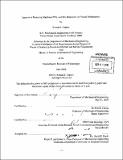| dc.contributor.advisor | Wai K. Cheng. | en_US |
| dc.contributor.author | Caputo, Ronald J., Jr. (Ronald Joseph) | en_US |
| dc.contributor.other | Massachusetts Institute of Technology. Dept. of Mechanical Engineering. | en_US |
| dc.date.accessioned | 2011-03-24T20:21:16Z | |
| dc.date.available | 2011-03-24T20:21:16Z | |
| dc.date.copyright | 2010 | en_US |
| dc.date.issued | 2010 | en_US |
| dc.identifier.uri | http://hdl.handle.net/1721.1/61883 | |
| dc.description | Thesis (S.M. in Naval Architecture and Marine Engineering)--Massachusetts Institute of Technology, Dept. of Mechanical Engineering; and, (S.M.)--Massachusetts Institute of Technology, Dept. of Mechanical Engineering, 2010. | en_US |
| dc.description | In title on title-page, double-underscored "x" appears as subscript. Cataloged from PDF version of thesis. | en_US |
| dc.description | Includes bibliographical references (p. 143-146). | en_US |
| dc.description.abstract | The international maritime community has been experiencing tremendous pressures from environmental organizations to reduce the emissions footprint of their vessels. In the last decade, air emissions, including nitrogen oxides (NOx), sulfur oxides (SOx), volatile organic compounds, and particulate matter, have become the focus. In an effort to regulate and gain control of vessel air pollution, in 1997, the International Maritime Organization created Annex VI, Regulations for the Prevention of Air Pollution from Ships, to the International Convention for the Prevention of Pollution from Ships (MARPOL Annex VI). Recently, in 2008, MARPOL Annex VI was amended to impose more stringent air emission regulations that will be enforced based on a tiered system that grows tighter with time. New technologies are under development to ensure new vessels can meet the stricter standards while maintaining propulsion plant performance. With the bulk of the international commercial fleet approaching its mid-service life, this thesis completes an analysis of retrofitting these new technologies to the existing power plants of vessels built in the 1990s, focusing on performance impacts in the way of specific fuel consumption, transit times and brake engine power output. Three types of commercial vessels are explored: bulk carriers, containerships and tank vessels. Maxsurf, an integrated naval architecture & ship construction software program, is utilized to parametrically develop 30 computer based hull models. The Hullspeed module of Maxsurf is then used to estimate speed-power curves for the hull models based on the Fung and Holtrop hull resistance and power estimations. The models' dimensions and power plants are taken from existing vessels constructed in the 1990s and obtained from the American Bureau of Shipping database (ABS Eagle). This thesis focuses on reducing NOx and SOx emissions from these vessels. Six air emission reducing technologies are explored including two after-treatment systems, selective catalytic reduction (SCR) and exhaust gas scrubbers, and four pre-combustion systems, direct water injection (DWI), fuel-water emulsification, exhaust gas recycle (EGR) and scavenge air moistening (SAM). The published performance impacts are applied to the vessels traveling on a hypothetical route comparing new transit times and increased fuel consumption. | en_US |
| dc.description.statementofresponsibility | by Ronald J. Caputo. | en_US |
| dc.format.extent | 146 p. | en_US |
| dc.language.iso | eng | en_US |
| dc.publisher | Massachusetts Institute of Technology | en_US |
| dc.rights | M.I.T. theses are protected by
copyright. They may be viewed from this source for any purpose, but
reproduction or distribution in any format is prohibited without written
permission. See provided URL for inquiries about permission. | en_US |
| dc.rights.uri | http://dspace.mit.edu/handle/1721.1/7582 | en_US |
| dc.subject | Mechanical Engineering. | en_US |
| dc.title | Impacts of reducing shipboard NOx̳ and SOx̳ emissions on vessel performance | en_US |
| dc.title.alternative | Impacts of reducing shipboard nitrogen oxide and sulfur oxide emissions on vessel performance | en_US |
| dc.type | Thesis | en_US |
| dc.description.degree | S.M. | en_US |
| dc.description.degree | S.M.in Naval Architecture and Marine Engineering | en_US |
| dc.contributor.department | Massachusetts Institute of Technology. Department of Mechanical Engineering | |
| dc.identifier.oclc | 706149411 | en_US |
